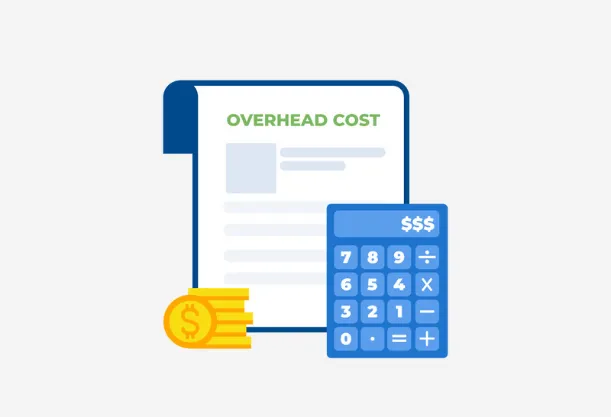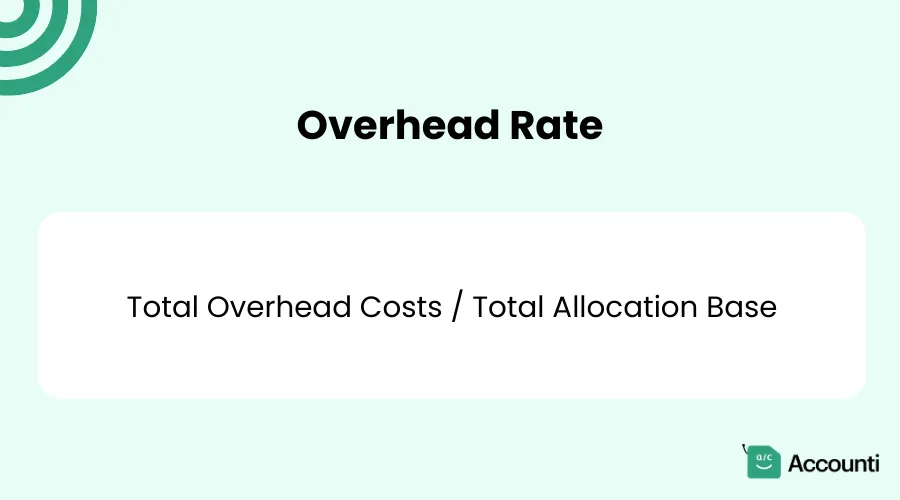
How to Calculate Overhead Cost: A Step-by-Step for Small Businesses Owners
Are you struggling to get a grip on your business expenses? Understanding how to calculate overhead costs is crucial for any business owner or manager.
In this article, we'll dive deep into the world of overhead costs, exploring what they are, why they matter, and most importantly, how to calculate them accurately.
The Hidden Costs of Doing Business
Every business, whether it's a small startup or a large corporation, incurs costs that aren't directly tied to producing goods or services.
These sneaky expenses, known as overhead costs, can make or break your bottom line if not managed properly. But don't worry – we're here to demystify this critical aspect of business finance.
Why Should You Care About Overhead Costs?
Think of overhead costs as the backstage crew of your business. They're not in the spotlight, but without them, the show can't go on. Understanding and calculating these costs is essential for:
- Setting the right prices for your products or services
- Creating accurate budgets and financial forecasts
- Analyzing your true profitability
So, let's roll up our sleeves and dive into the nitty-gritty of overhead costs!
What Are Overhead Costs?
Before we jump into calculations, let's make sure we're all on the same page about what overhead costs actually are.
Definition of Overhead Costs
Overhead costs are the ongoing expenses incurred in operating a business that aren't directly tied to creating a product or service. In other words, these are the costs you'd still have to pay even if you weren't producing anything.
But wait, how do overhead costs differ from direct costs? Here's a quick comparison:
- Direct costs: Expenses directly related to producing goods or services (e.g., raw materials, labor for production)
- Overhead costs: Expenses not directly tied to production but necessary for business operations
Types of Overhead Costs
Not all overhead costs are created equal. They generally fall into three categories:
- Fixed Overhead Costs
- Remain constant regardless of business activity
- Examples: rent, salaries of administrative staff, insurance premiums
- Variable Overhead Costs
- Fluctuate based on business activity
- Examples: utilities, office supplies, shipping costs
- Semi-Variable Overhead Costs
- Have both fixed and variable components
- Examples: maintenance costs, some administrative expenses
Examples of Overhead Costs
To give you a better idea, here's a list of common overhead costs:
- Rent or mortgage payments
- Utilities (electricity, water, gas)
- Insurance
- Administrative salaries
- Office Supplies
- Marketing and advertising
- Legal and accounting fees
- Depreciation of assets
- Property taxes
Why Calculating Overhead Costs Is Important
Now that we know what overhead costs are, let's explore why calculating them accurately is crucial for your business success.
Impact on Pricing
Have you ever wondered how businesses decide on their prices? Overhead costs play a significant role in this process. By understanding your total overhead, you can:
- Set prices that cover all your costs and ensure profitability
- Avoid underpricing your products or services
- Stay competitive in the market without cutting into your profits
Budgeting and Financial Planning
Imagine trying to plan a road trip without knowing how much gas your car consumes. That's what financial planning without accurate overhead calculations is like. Knowing your overhead helps you:
- Create realistic budgets
- Make informed decisions about expansion or cost-cutting
- Prepare for lean periods by understanding your minimum operating costs
Profitability Analysis
At the end of the day, you're in business to make money, right? Understanding your overhead is key to analyzing your true profitability. It allows you to:
- Determine which products or services are most profitable
- Identify areas where costs can be reduced to improve profitability
- Make informed decisions about discontinuing unprofitable product lines
Steps to Calculate Overhead Costs
Alright, it's time to roll up our sleeves and get into the nitty-gritty of calculating overhead costs. Don't worry – we'll break it down into manageable steps.
Step 1: Identify All Overhead Costs
First things first, you need to gather all your overhead expenses. This is like a scavenger hunt through your financial records. Here's a checklist to get you started:
- Rent or mortgage payments
- Utilities
- Insurance premiums
- Administrative salaries
- Office supplies
- Marketing and advertising expenses
- Legal and accounting fees
- Depreciation of equipment and buildings
- Property taxes
- Maintenance costs
Remember, the goal is to capture all costs that aren't directly tied to producing your goods or services.
Step 2: Classify the Overhead Costs
Now that you've got your list, it's time to sort these costs into categories. Think of it as organizing your financial closet. You'll want to group your overhead costs into:
- Fixed costs (don't change with production levels)
- Variable costs (fluctuate with production)
- Semi-variable costs (have both fixed and variable components)
This classification will help you understand how these costs behave as your business activity changes.
Step 3: Choose an Allocation Base
Here's where it gets a bit tricky. You need to choose a basis for allocating these overhead costs to your products or services. Common allocation bases include:
- Direct labor hours
- Machine hours
- Units produced
- Square footage (for rent and utilities)
The key is to choose a base that makes sense for your business and correlates well with how you incur overhead costs.
Step 4: Calculate the Overhead Rate
Now we're getting to the math part! Don't worry, it's not as scary as it sounds. The overhead rate is calculated using this formula:

Overhead Rate = Total Overhead Costs / Total Allocation Base
For example, if your total overhead costs are $100,000 and you choose direct labor hours as your allocation base, with 5,000 total labor hours:
Overhead Rate = $100,000 / 5,000 hours = $20 per labor hour
This means for every hour of direct labor, you're incurring $20 in overhead costs.
Step 5: Allocate Overhead Costs to Products/Services
The final step is to apply this rate to your products or services. Let's say you're making custom furniture, and a particular chair takes 2 hours of direct labor to produce. Your overhead allocation for this chair would be:
Overhead Allocation = Overhead Rate x Direct Labor Hours
Overhead Allocation = $20 x 2 hours = $40
This $40 represents the overhead cost you should consider when pricing this chair, in addition to the direct costs of materials and labor.
Common Methods for Allocating Overhead Costs
Now that we've covered the basic process, let's explore some specific methods for allocating overhead costs. Each has its pros and cons, and the best choice depends on your business type and needs.
Traditional Costing Method
This is the simplest method and works well for many small businesses. Here's how it works:
- Sum up all overhead costs
- Choose a single allocation base (like direct labor hours)
- Calculate the overhead rate
- Apply this rate to all products or services
Example:
Total overhead: $500,000 Total direct labor hours: 25,000 Overhead rate: $500,000 / 25,000 = $20 per labor hour
For a product that takes 5 labor hours to produce: Allocated overhead = 5 hours x $20 = $100
Pros:
- Simple to understand and implement
- Works well for businesses with homogeneous products
Cons:
- May not accurately reflect cost differences between diverse products
- Can lead to over or under-costing in complex operations
Activity-Based Costing (ABC)
ABC is a more sophisticated method that aims to allocate overhead costs more accurately by identifying specific activities that drive costs.
How it works:
- Identify major activities that generate overhead costs (e.g., machine setups, quality inspections)
- Determine the cost of each activity
- Choose cost drivers for each activity (e.g., number of setups, inspection hours)
- Calculate activity rates
- Assign costs to products based on their use of each activity
Benefits of using ABC:
- More accurate cost allocation for diverse product lines
- Better understanding of what drives costs in your business
- Improved decision-making for pricing and product mix
Drawbacks:
- More complex to implement and maintain
- Requires detailed activity data
Job Order Costing and Process Costing
These methods are specific to certain types of businesses:
- Job Order Costing:
- Used when products are made to order and each job is unique. Overhead is allocated to specific jobs.
- Process Costing:
- Used in continuous production environments where products are homogeneous. Overhead is allocated to production departments and then to units produced.
Tips for Managing Overhead Costs
Calculating overhead is just the first step. The real power comes from using this information to manage and optimize your costs. Here are some strategies to keep your overhead in check:
Regularly Review Overhead Expenses
Make it a habit to review your overhead costs periodically. Ask yourself:
- Are all these expenses still necessary?
- Can we negotiate better rates with suppliers?
- Are there new technologies or methods that could reduce these costs?
Implement Cost-Cutting Measures
Once you've identified areas for improvement, take action:
- Consider outsourcing non-core functions
- Implement energy-saving measures to reduce utility costs
- Explore remote work options to reduce office space needs
- Negotiate better terms with vendors and suppliers
Leverage Technology
In today's digital age, technology can be a powerful ally in managing overhead:
- Use accounting software to track and categorize expenses automatically
- Implement inventory management systems to optimize stock levels
- Utilize project management tools to improve efficiency and reduce waste
Remember, the goal isn't just to cut costs blindly, but to optimize your overhead to support your business goals efficiently.
Conclusion
Calculating and managing overhead costs is a crucial skill for any business owner or manager. By understanding what overhead costs are, how to calculate them, and how to allocate them effectively, you're equipping yourself with powerful tools for financial decision-making.
Remember, the process of calculating overhead isn't a one-time task. As your business grows and changes, so too will your overhead costs. Make it a regular practice to review and recalculate your overhead, and use this information to drive continuous improvement in your business operations.
By mastering the art of overhead cost calculation and management, you're setting your business up for long-term success and profitability. So go ahead, and dive into those numbers.

 Rohit Kapoor
Rohit Kapoor

